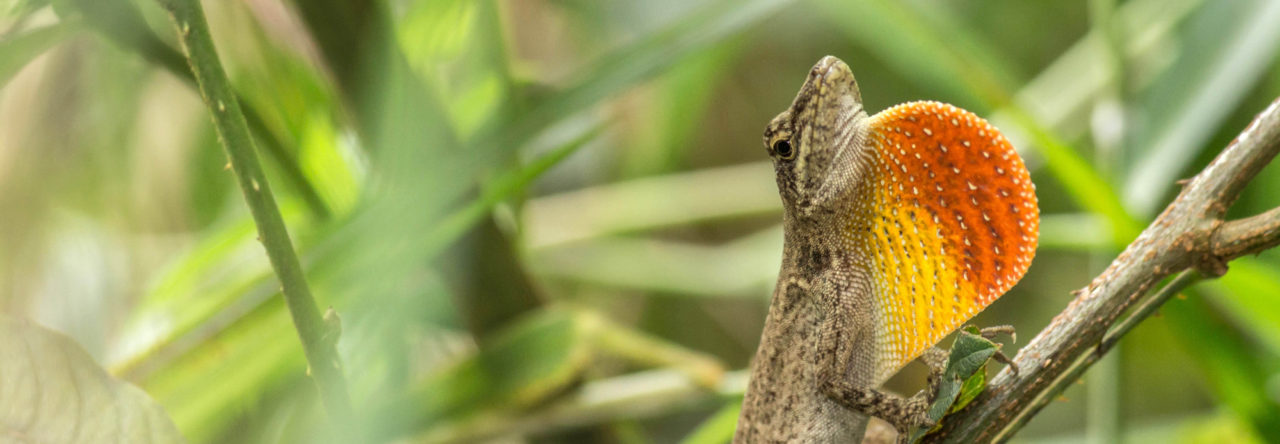 Green anoles (Anolis carolinensis) are everywhere in the southeastern United States, thriving in habitats that range from the balmy warmth of Miami to the cooler, more seasonal climates of Tennessee. But how do they manage to adapt so successfully across such different environments? At SICB 2025, Morgan Muell presented exciting research that tackled this question, focusing on how green anoles balance genetic and environmental factors to drive local adaptation.
Green anoles (Anolis carolinensis) are everywhere in the southeastern United States, thriving in habitats that range from the balmy warmth of Miami to the cooler, more seasonal climates of Tennessee. But how do they manage to adapt so successfully across such different environments? At SICB 2025, Morgan Muell presented exciting research that tackled this question, focusing on how green anoles balance genetic and environmental factors to drive local adaptation.
Green anoles are especially intriguing for studies on adaptation because of their unique life history traits. Females lay single-egg clutches and provide no parental care, meaning the developmental environment plays a huge role in shaping the traits of their offspring. Muell’s research explored how northern and southern populations differ in their developmental strategies. Specifically, the study tested whether northern anoles, which face shorter summers and more variable temperatures, are adapted to develop faster in cooler conditions—a phenomenon known as countergradient variation. Another question Muell asked was whether northern populations show larger body sizes by amplifying the effects of warm developmental environments, which would suggest cogradient variation.
To test these ideas, Muell and team collected eggs from seven green anole populations ranging from Tennessee to Miami. Eggs were incubated at three temperatures (22°C, 26°C, and 30°C) to mimic the range of natural conditions experienced during development. They measured the incubation period and the hatchlings’ snout-vent length to see if these traits varied depending on population origin and incubation temperature.
The results were both surprising and exciting! Northern populations showed evidence of countergradient variation, with eggs from cooler climates developing significantly faster at lower temperatures than their southern counterparts. This adaptation likely helps northern anoles’ offspring survive and grow quickly enough to make it through shorter growing seasons. Interestingly, when it came to hatchling body size, there wasn’t much spatial variation—northern hatchlings weren’t consistently larger than southern ones, despite initial expectations.
However, the story doesn’t end here. A closer look at maternal traits revealed an important twist. Northern females laid larger eggs earlier in the summer compared to their southern counterparts, giving their offspring a developmental head start regardless of incubation conditions. This maternal strategy appears to complement the faster developmental rates seen in northern populations, ensuring that offspring are well-equipped to survive the challenges of their local environment.
Muell’s research highlights how complex potential local adaptation can be. While developmental plasticity in traits like incubation period helps anoles respond to environmental constraints, maternal strategies play an equally important role in shaping offspring success. Together, these factors allow green anoles to thrive across such a wide range of climates. Muell’s work also underscores the importance of CovGE, which examines how spatial covariance between genotype and environment influences adaptive traits. By applying this framework to green anoles, Muell has provided new insights into the mechanisms driving local adaptation.
As climate change continues to reshape habitats, understanding the strategies animals use to adapt will become increasingly important. For green anoles, it’s clear that both plasticity and maternal investment are key to their success—a fascinating reminder of the complex interplay between genetics, environment, and evolution.
Want to learn more about Morgan Muell’s work? You can find her website here:https://morganmuell.wixsite.com/home
She’s also currently looking for postdocs!
- SICB 2025: How Hormones Enhance Anole Communication - January 31, 2025
- SICB 2025: How Green Anoles Adapt to Local Climates - January 26, 2025


Leave a Reply